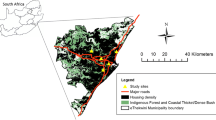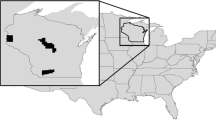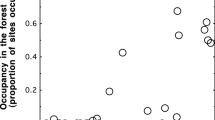Abstract
There is debate among ecologists about whether total habitat area or patch arrangement contributes most to population and/or community responses to fragmented or patchy landscapes. We tested the relative effects of patch area and isolation for predicting bird occurrence in a naturally patchy landscape in the Bear River Mountains of Northern Utah, USA. We selected focal patches (mountain meadows) ranging in elevation from 1,920 to 2,860 m and in size from 0.6 to 182 ha. Breeding birds were sampled in each focal meadow during the summers of 2003 and 2004 using variable-distance point transects. Logistic regression and likelihood-based model selection were used to determine the relationship between likelihood of occurrence of three bird species (Brewer’s sparrow, vesper sparrow, and white-crowned sparrow) and area, isolation, and proximity metrics. We used model weights and model-averaged confidence intervals to assess the importance of each predictor variable. Plots of area versus isolation were used to evaluate complex relationships between the variables. We found that meadow area was the most important variable for explaining occurrence for two species, and that isolation was the most important for the other. We also found that the absolute distance was more appropriate for evaluating isolation responses than was the species-specific proximity metric. Our findings add clarity to the debate between ecologists regarding the relative importance of area and isolation in species responses to patchy landscapes.





Similar content being viewed by others
References
Andrewartha HG, Birch LC (1954) The distribution and abundance of animals. University of Chicago Press, Chicago
Bissonette JA (2003) Linking landscape patterns to biological reality. In: Bissonette JA, Storch I (eds) Landscape ecology and resource management: linking theory with practice. Island Press, Washington, pp 15–34
Bowman J (2003) Is dispersal distance of birds proportional to territory size? Can J Zool 81:195–202. doi:10.1139/z02-237
Buckland ST, Anderson DR, Burnham KP et al (1993) Distance sampling: estimating abundance of biological populations. Chapman and Hall, London
Burnham KP, Anderson DR (2002) Model selection and multimodel inference: a practical information-theoretic approach, 2nd edn. Springer, New York
Chilton GM, Baker MC, Barrentine CD et al (1995) White-crowned Sparrow (Zonotrichia leucophrys). In: Poole A, Gill F (eds) The birds of North America, No. 183. The Birds of North America, Inc, Philadelphia
Clergeau P, Burel F (1997) The role of spatio-temporal patch connectivity at the landscape level: and example in a bird distribution. Landsc Urban Plan 38:37–43. doi:10.1016/S0169-2046(97)00017-0
Dunning JB, Danielson BJ, Pulliam HR (1992) Ecological processes that affect populations in complex landscapes. Oikos 65:169–175. doi:10.2307/3544901
ESRI Inc (1999) ArcView GIS 3.2a. Environmental Systems Research Institute Inc., Redlands
Fahrig L (2003) Effects of habitat fragmentation on biodiversity. Annu Rev Ecol Evol Syst 34:287–515. doi:10.1146/annurev.ecolsys.34.011802.132419
Fahrig L (2007) Non-optimal animal movement in human-altered landscapes. Funct Ecol 21:1003–1015. doi:10.1111/j.1365-2435.2007.01326.x
Fazey I, Fischer J, Lindenmayer DB (2005) What do conservation biologists publish? Biol Conserv 124:63–73. doi:10.1016/j.biocon.2005.01.013
Fischer J, Lindenmayer DB (2007) Landscape modification and habitat fragmentation: a synthesis. Glob Ecol Biogeogr 16:265–280. doi:10.1111/j.1466-8238.2007.00287.x
Hahn D (2002) Point dispersion wizard. Avenue script. http://arcscripts.esri.com/details.asp?dbid=12538
Haila Y (2002) A conceptual genealogy of fragmentation research: from island biogeography to landscape ecology. Ecol Appl 12(2):321–334
Hanski I (2004) Metapopulation biology: past, present, and future. In: Hanski I, Gaggiotti OE (eds) Ecology, genetics and evolution of metapopulations. Elsevier, Burlington, pp 3–22
Jones SL, Cornely JE (2002) Vesper Sparrow (Pooecetes gramineus). In: Poole A, Gill F (eds) The birds of North America, No. 624. The Birds of North America, Inc., Philadelphia
Levins R (1969) Some demographic and genetic consequences of environmental heterogeneity for biological controls. Bull Entomol Soc Am 15:237–240
Levins R (1970) Extinction. In: Ferstenhaber M (ed) Lectures in mathematics for biology, vol 2. American Mathematics Society, Providence, pp 77–107
Lindenmayer DB, Fischer J (2006) Habitat fragmentation and landscape change: an ecological and conservation synthesis. Island Press, Washington
Lindenmayer DB, Cunningham RB, Donnelly CF et al (2002) Effects of forest fragmentation on bird assemblages in a novel landscape context. Ecol Monogr 72:1–18
Lynch JF, Whigham DF (1984) Effects of forest fragmentation on breeding bird communities in Maryland, USA. Biol Conserv 28:287–324. doi:10.1016/0006-3207(84)90039-9
MacArthur RH, Wilson EO (1967) The theory of island biogeography. Princeton University Press, Princeton
McGarigal K, Cushman SA, Neel MC et al (2002) FRAGSTATS: spatial pattern analysis program for categorical maps. University of Massachusetts, Amherst
Moilanen A, Nieminen M (2002) Simple connectivity measures in spatial ecology. Ecology 83:1131–1145
O’Neill RV, Milne BT, Turner MG et al (1988) Resource utilization scales and landscape pattern. Landscape Ecol 2:63–69. doi:10.1007/BF00138908
Rotenberry JT, Patten MA, Preston KL (1999) Brewer’s Sparrow (Spizella breweri). In: Poole A, Gill F (eds) The birds of North America, No. 390. The Birds of North America, Inc, Philadelphia
SAS Institute Inc. (2004) SAS 9.1.3 help and documentation. The SAS Institute, Cary
Villard M-A (2002) Habitat fragmentation: major conservation issue or intellectual attractor? Ecol Appl 12:319–320. doi:10.1890/1051-0761(2002)012[0319:HFMCIO]2.0.CO;2
Villard M-A, Merriam G, Maurer BA (1995) Dynamics in subdivided populations of neotropical migratory birds in a fragmented temperate forest. Ecology 76:27–40. doi:10.2307/1940629
Whitcomb RF, Robbins CS, Lynch JF et al (1981) Effects of forest fragmentation on avifauna of eastern deciduous forest. In: Burgess RL, Sharpe DM (eds) Forest island dynamics in man-dominated landscapes. Springer, New York, pp 125–205
Wiens JA (1987) Habitat occupancy patterns of North American shrubsteppe birds: the effects of spatial scale. Oikos 48:132–147. doi:10.2307/3565849
Wiens JA, Schooley RL, Weeks RD Jr (1997) Patchy landscapes and animal movements: do beetles percolate? Oikos 78:257–264. doi:10.2307/3546292
With KA, Cadaret SJ, Davis C (1999) Movement responses to patch structure in experimental fractal landscapes. Ecology 80:1340–1353
Acknowledgments
This research was funded by the US Forest Service, and supported by the USGS Utah Cooperative Fish and Wildlife Research Unit (cooperators: Utah State University, Utah Division of Wildlife Resources, US Geological Survey, Wildlife Management Institute, and the US Fish and Wildlife Service), and the Utah State University Ecology Center. Clint McCarthy of USFS provided early vision for this project, and was instrumental in creating funding opportunities. Marmot Mountain L.L.C. provided camping gear for use in the field. We thank James A. MacMahon, Andreas Leidolf, and Patricia Crammer for their comments and reviews of thesis drafts, and Drs. Thomas C. Edwards Jr, and David Koons for help with analyses. We also thank our field technicians for their dedication and acceptance of extreme working conditions. Thanks to Jingle Wu for helping to re-frame the discussion and for giving the MS a second chance. This manuscript was much improved thanks to insightful reviews by Drs. John Dunning, Eric Bollinger, A. Joshua Leffler, Helene Wagner and several anonymous referees. All URLs, including those listed for relevant software packages, were checked in November 2007, prior to submission of this article. Floral references follow USDA nomenclature available at http://plants.usda.gov. The use of trade or firm names in this paper is for reader information only and does not imply endorsement by the US Geological Survey of any product or service.
Author information
Authors and Affiliations
Corresponding author
Rights and permissions
About this article
Cite this article
Wilson, T.L., Johnson, E.J. & Bissonette, J.A. Relative importance of habitat area and isolation for bird occurrence patterns in a naturally patchy landscape. Landscape Ecol 24, 351–360 (2009). https://doi.org/10.1007/s10980-008-9309-5
Received:
Accepted:
Published:
Issue Date:
DOI: https://doi.org/10.1007/s10980-008-9309-5




